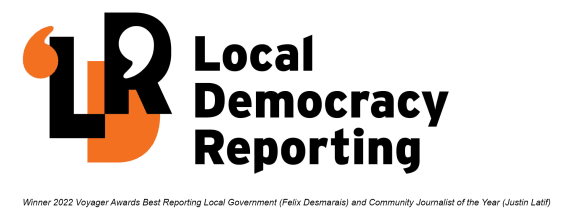
A 7 March view of the gap in the northern protection bank looking up the Wanganui River when West Coast Regional Council members visited the site. Less than 48 hours later the river changed course through the gap and in the latest event at least a further 200m of stop bank have since washed away. Photo: Greymouth Star/ Brendon McMahon
South Westland farmers are counting the cost after a flooded Wanganui River sent a deluge through their land for the second time in a fortnight.
The latest flood was "way worse" than the 9 March event when the river broke through a hole in the northern bank, below Evans Creek.
On the Wanganui River north bank this morning Lake Ianthe farmer of more than 40 years, Andy Campbell, said the water was "lapping" at his cow shed.

The first term West Coast Regional councillor and Wanganui Rating District spokesman said it was "at least a metre higher" than 9 March.
He was putting a brave face on it but feared the worst.
"What can we do? We didn't fix it when we had the opportunity, and now we're going to pay."
He understood nearby Hari Hari township had at least 80mm in an hour last night.
The nearest West Coast Regional Council hydrological site, on the Whataroa River about 35km south, had 182mm in the 24 hours to 7.30am today.
More than 5km of ruined fence lines, and a mass of silt and debris across at least 20ha of low lying land, was the result for Campbell.
"I've just got my head above water," he said.
"There's still a good flow coming down ... we just need a break in the weather."
But the latest event could permanently compromise his farm and his neighbour.
"If we get a channel in here, that's it -- it's a write off."

The latest deluge over Bernard Walkington's farm is about a metre higher than what occurred when the Wanganui River broke through, as seen here on 7 March. Photo: LDR/ Supplied
Campbell estimated his upstream neighbour Bernard Walkington had lost up to 30ha of productive land due to the flood.
Walkington said while the water had yet to recede he could see the clean up this time would "be substantially more".
The gap in the protection bank bordering his land had opened up even more.
"It's huge now -- it's massive."
Heavy logs and other heavy debris were tangled in fences and strewn everywhere, with stock water lines and farm tracks also bearing the brunt, he said.
With the regional council "p***g around" organising a repair since 9 March, he said he had kept stock out of the low lying land.
"We've stayed right away from that area since last time -- it's too risky," Walkington said.
"It's pretty frustrating. There was a small amount of damage last time and I was prepared to fix it. Now you are looking at a substantial fixup -- and who's liable?"
A stormy rating district meeting in Hari Hari on 7 March put the regional council on notice following the Waitangi weekend storm which saw the river cut through.
By then the council had had three fine weeks but less than 48 hours later a "moderate" flood sent the river through the hole.
Campbell said council had finally started towards a repair, with work to divert the river away from the gap in the bank completed by last Thursday night.
But bad weather into Friday morning had sent the river back towards the hole.
Acting council chair Peter Haddock said today council had let a contract last week to "remediate" the hole.
The two stage contract was to cart rock and then undertake the rebuild and he understood things were in hand.
Campbell acknowledged the affected area was "low lying" but it was also productive freehold land which had been farmed trouble free for decades.
"That's why the stopbank was built."
While the banks were regularly maintained there was never an issue and the event which blew out the protection in the first place should have been "only a minor hiccup" pending an immediate repair.
But now what might have been an $80,000 cost to the rating district to repair had escalated in cost by hundreds of thousands, Campbell said.
Local Democracy Reporting is Public Interest Journalism funded through NZ On Air



